|
|

|
|
Author
|
Topic: Space Cover 753: Favorite programs 1972-82
|
Bob M
Member Posts: 1909
From: Atlanta-area, GA USA
Registered: Aug 2000
|
 posted 05-12-2024 08:27 AM
posted 05-12-2024 08:27 AM
   
Space Cover of the Week, Week 753 (May 12, 2024)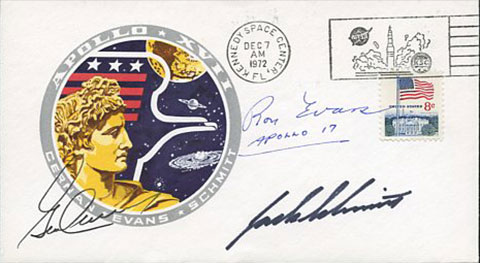 Space Cover 753: My Favorite Programs/Covers, 1972-82I began collecting space covers in 1972 with Apollo 17 and continued with great enthusiasm for over 40 years. I was fortunate to be a space fan and collector during a significant part of the golden age of space cover collecting. In my opinion the "golden age" would be from Explorer 1 in 1958 to the early part of the shuttle program in 1982. So I have decided to feature here one or two of my favorite covers from significant U.S. space programs from the 1972 to 1982 time frame. Covers shown are from Apollo 17, X-24B Lifting Body, Skylab, ASTP, Viking, Enterprise/ALT, STS-1 and the OFTs. During that 1972-82 ten year period, space and space cover collecting was extremely popular, with many collectors, cover servicers/designers, dealers and small auctions all actively involved and busy. It was a great time to be a collector and many wonderful memories and covers resulted from that era for all of us. X-24B Lifting Body Test Program: Public Affairs Office cacheted cover for the final flight in the X-24B flight program, signed by the six pilots, including Mike Love, killed in an aircraft accident shortly after the end of the program, and Dick Scobee, lost on Challenger. 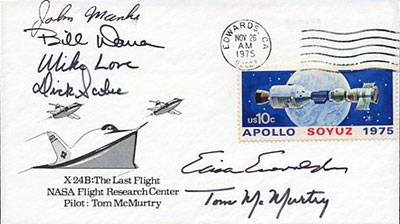 Skylab Space Station: Official NASA/KSC cacheted cover for the Skylab-1 Orbital Workshop launch and also Skylab's final day in orbit. Skylab 1's time in space included 34,981 orbits. Second cover is for the final day in orbit and signed by the nine Skylab astronauts 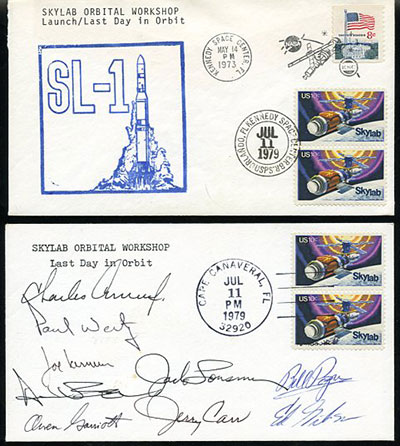 Apollo-Soyuz Test Project (ASTP): First cover is canceled at Moscow for the Soyuz launch and then at Cape Canaveral for the Apollo launch on the same day. Special arrangements were made by German dealer Eberhard Colle to fly the Soyuz launch canceled covers to the US after being canceled in Moscow. Then later it was signed by the Apollo crew. The second cover was canceled on board the Prime Recovery Ship USS New Orleans the day after splashdown (the ship's post office was closed on the day of splashdown), and bears the ship's official rubber stamp cachet and the Apollo crew's autographs. 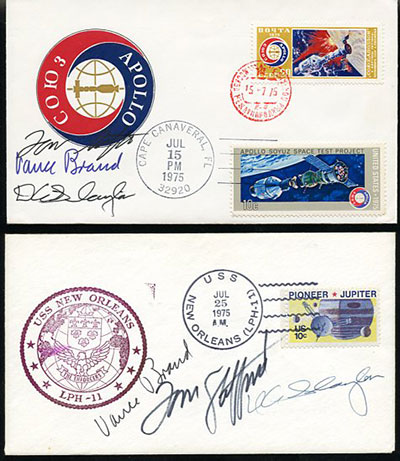 Viking Mars Landing: The first cover was canceled for both Viking 1 and Viking 2 launches. The second cover has an official Viking Martin Marietta rubber stamp cachet and is canceled for both Viking launches and also with Denver, CO cancels for each Viking's Mars landing. Martin Marietta, of Denver, CO, was the primary builder of the Viking spacecraft. Also during the 1970's, launches of both Voyager 1 and 2, and Pioneer 10/11 occured and then their very, very long-distance voyages of discovery. 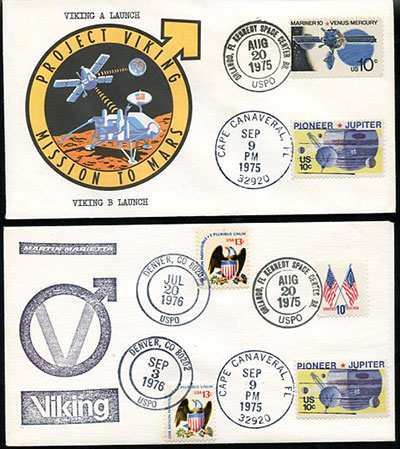 Shuttle Enterprise/Approach and Landing Tests: Dryden Flight Research Center cover for the first Enterprise ALT free flight and autographed by the two astronaut pilots. And Rockwell Space Division Stamp Club cover for Enterprise's rollout from its assembly plant in Palmdale, CA, and also canceled for the final ALT free flight, and autographed by both Enterprise/ALT astronaut two-man crews. 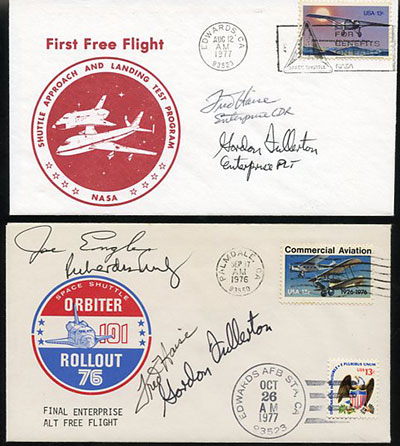 STS-1 and Orbital Flight Tests (OFT): Cover canceled at KSC for the first shuttle launch and then flown by a NASA aircraft to Edwards AFB and canceled there for Columbia's landing, and later signed by the crew. Second cover canceled at KSC for the four Orbital Flight Tests. 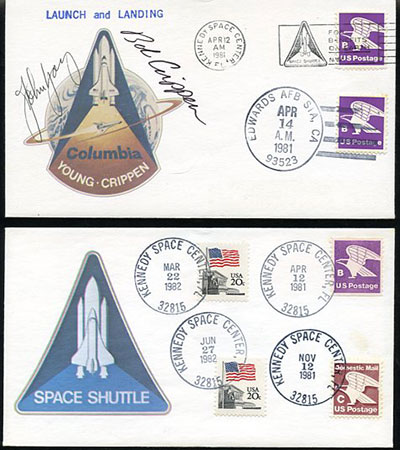 Perhaps others may have favorite covers they'd like to show from this very special 1972-82 time period. |
micropooz
Member Posts: 1772
From: Washington, DC, USA
Registered: Apr 2003
|
 posted 05-12-2024 10:09 AM
posted 05-12-2024 10:09 AM
   
Cool topic Bob!The M2F3 Lifting Body Program wrapped up in 1972, with the last flight being December 20, 1972. The M2F3 along with the X24B mentioned above, and the other lifting bodies contributed a lot of data on how to land an unpowered Space Shuttle. Here is a cover that was flown on John Manke's first flight in the M2F3 on October 19, 1972:  |
Ken Havekotte
Member Posts: 3813
From: Merritt Island, Florida, Brevard
Registered: Mar 2001
|
 posted 05-12-2024 04:36 PM
posted 05-12-2024 04:36 PM
   
Very much enjoyed this cS topic of favorite cover programs from 1972-82, which as Bob and Dennis know, was a wonderful decade for space cover collectors with so many milestone accomplishments in aerospace research, rocketry, space flight exploration, and with many new discoveries in astronomy and space sciences.Can I add two major deep space flight programs that have always been a favorite of mine from this exciting era; those of NASA's Pioneer 10, 11, and Voyager 1 and 2. Below is a montage of less than a dozen different Pioneer 10/11 highlight covers from first launch in 1972 ending with Pioneer 10 becoming the first manmade object to leave the solar system in 1983. Those cachet makers are Centennial, Space Voyage (Rank), KSCPS, Whitney RSC, McLeod type-written, and a couple of ONC's from NASA's Ames Research Center with an added McCall hand-drawn artwork on one of them.  There are so many other wonderful Pioneer 10/11 cover issues commemorating the many first-time achievements and pioneering-making events in space flight history. The same could also apply to the twin Voyager space probes launched in 1977, know as The Interstellar Missions, of Jupiter, Saturn, Uranus, Neptune, and for their discoveries of 22 moons of those planetary systems. As a side note from a personal perspective, I was indeed fortunate to had been a very small part of the later Pioneer and Voyager launch events as a news media participate here at the Cape with many found memories of those coverages. |
Axman
Member Posts: 454
From: Derbyshire UK
Registered: Mar 2023
|
 posted 05-13-2024 09:23 AM
posted 05-13-2024 09:23 AM
   
SPACE AGES.Great topic, and contributions to it. But allow me a sideline into it, a possibly contentious nitpicking... is the period 1972-1982 really a part of the "Golden years"? We've all heard of the space race, the race to the moon. I think it is fairly undisputed that the Space Age began with the race into space, and as such is synonymous with the Golden era of the Space Age... and I think we can all agree that Sputnik 1 was the starting pistol. But when was the finish line? 1969, 1972, or later? Personally speaking I think the end of 1972 is the cut-off for the "Golden" age.
1972-1982, in my opinion, is the "silver" age. The period up until the end of the Apollo moonshots [1972] encompasses most of the outstanding space landmarks: - First commercial satellite
- First communications satellite
- First Geostationary satellite
- First spy satellite
- First military satellite
- First weather satellite
- First geo-resources satellite
- First navigation satellite
- First probe into outer space
- First probe to photograph the backside of the moon
- First probe to reach Venus
- First probe to reach Mars
- First probes to land on extraterrestrial objects
- First manned spacecraft
- First manned lunar orbit
- First manned lunar landing
- First re-used spacecraft
- First space station
- First probe to the outer planets
- Launch of first probe to leave the solar system
And many many more firsts...The period 1972-1982 was just a consolidation of what went before and a breathing period before we settled into the "bronze age" of manned near Earth orbit/space station exploration, and an extension inwards and outwards of solar system probes. I'm not denying the value of collecting the space covers associated with the programs of the era, but I'm a little reluctant to admit 1972-1982 into the 'Golden Era'. |
rvk
Member Posts: 40
From: Highlands Ranch, CO USA
Registered: Jul 2020
|
 posted 05-13-2024 04:30 PM
posted 05-13-2024 04:30 PM
   
I would like to add a few of my own envelopes to the list of planetary exploration covers shown. The seventies were definitely the age of outer planet exploration. While the inner planets were already being explored, the outer planets beyond the asteroid belt proved challenging. The danger of flying through the belt was unknown, and there was also the problem of power to the spacecraft. Solar panels can be used to power spacecraft out to Mars, but not beyond. The Pioneer spacecraft used radioisotope thermoelectric generators (RTGs) that was new technology at that time for planetary exploration, and they worked very well. The Pioneer 10/11 spacecraft were the 'pathfinders' for every deep space mission that followed. I was fortunate to be a part of this program as a spacecraft mission controller. One of the photos shows the mission control room in Building 244 at NASA/ARC. The console in the back is where we sent commands to the spacecraft and monitored the spacecraft telemetry. Dr. Richard Fimmel is seated in the front of the picture on the left side, with tie.  



|
Bob M
Member Posts: 1909
From: Atlanta-area, GA USA
Registered: Aug 2000
|
 posted 05-14-2024 07:39 AM
posted 05-14-2024 07:39 AM
   
Alan, aka Axman, listed many historic and significant space achievements during the golden age/era of space exploration that certainly began with Sputnik 1. But the point of this SCOTW was not about the golden age of space exploration, but the undefined golden age of *space cover collecting* and to give us collectors an opportunity to display some of our special covers from that great time to be a space cover collector (and also, a great time to be a space autograph collector). So just in my opinion, I would again suggest the span from Explorer 1 to the very early shuttle program to be the golden age of space cover collecting. But certainly others would say that it ended after ASTP or after Apollo 17. But certainly Skylab, Enterprise/ALT and STS-1 had great collector interest and resulted in much space cover activity. And to finish, I would feel confident in saying that the 1960's were the heart of space cover collecting, with Mercury, Gemini, Apollo 8 and Apollo 11. Wish I had started collecting in 1962 instead of 1972. |
Axman
Member Posts: 454
From: Derbyshire UK
Registered: Mar 2023
|
 posted 05-14-2024 08:05 AM
posted 05-14-2024 08:05 AM
   
Cheers Bob. I appreciate your distinction between a golden age of space exploration, and a golden age of collecting space covers. I must admit that I hadn't considered the differentiation that is engendered by that point of view, but I concede I should have done.I withdraw my argument. 1958-1982 was a truly Golden Era for space collectors. |
Bob M
Member Posts: 1909
From: Atlanta-area, GA USA
Registered: Aug 2000
|
 posted 05-20-2024 05:39 PM
posted 05-20-2024 05:39 PM
   
To continue with my estimation of when the undefined Golden Age of Space Cover Collecting began and ended - Explorer 1/1958 and the early phase of the shuttle program/1982 - has been accepted by two of us, but, whatever, it was certainly a wonderful and productive time to be a space cover collector.But some others from the silent majority out there in Space Cover Land may feel that the golden age ended after the Apollo-Soyuz Test Project (ASTP) in 1975. That's certainly valid and most certainly a huge amount of covers for just about every test and event related to ASTP was churned out. And that may have been the highpoint before interest began to wane - but certainly Skylab, Enterprise/ALT and STS-1 staged a big comeback. So, for any who may consider ASTP as the end of the golden age of space cover collecting, I've posted two more of my favorite ASTP covers. 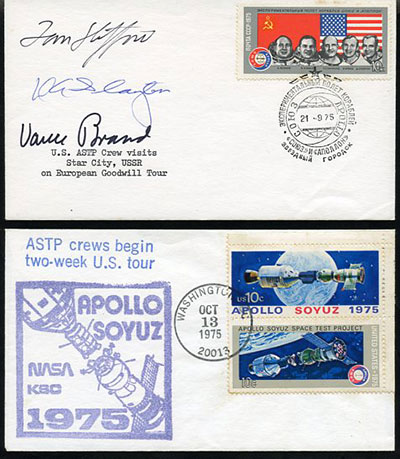 Both covers commemorate the ASTP post-flight Goodwill Tour that the Apollo and Soyuz crews embarked on together. The USSR/European tour began on September 21, 1975 and the US tour began on October 13 in Washington, DC (Covers exist for most of the cities on the US tour). The Soviet cover (with a special Soviet ASTP stamp picturing the five ASTP crew members) came from well-known early collector Leo Malz and the cancel was said to be rare and I believe is from Star City. The US crew's autographs were obtained via mail-in requests in 1978. The US Tour cover, with an impressive pair of the US ASTP stamps, came via dealer Sean Marsar with an ASTP official NASA/KSC rubber stamp cachet, that was intended to be used only on launch covers. |
bobslittlebro
Member Posts: 267
From: Douglasville, Ga U.S.A.
Registered: Nov 2009
|
 posted 05-21-2024 05:24 PM
posted 05-21-2024 05:24 PM
   
Great covers as always Bob. |
Bob M
Member Posts: 1909
From: Atlanta-area, GA USA
Registered: Aug 2000
|
 posted 05-22-2024 10:24 AM
posted 05-22-2024 10:24 AM
   
Thanks, Tim. The covers we've shown are just a very small sample of the vast number and variety of space covers that resulted from the 1972-1982 time period of space exploration. Whatever time period would be considered the Golden Age of Space Cover Collecting could very well include the 1972-82 period, in one collector's opinion. | |
Contact Us | The Source for Space History & Artifacts
Copyright 1999-2024 collectSPACE. All rights reserved.

Ultimate Bulletin Board 5.47a
|
|

|
 advertisement advertisement

|


























